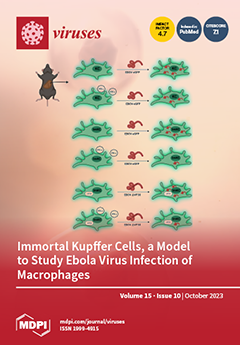African swine fever virus (ASFV) is a structurally complex, double-stranded DNA virus, which causes African swine fever (ASF), a contagious disease affecting swine. ASF is currently affecting pork production in a large geographical region, including Eurasia and the Caribbean. ASFV has a large
[...] Read more.
African swine fever virus (ASFV) is a structurally complex, double-stranded DNA virus, which causes African swine fever (ASF), a contagious disease affecting swine. ASF is currently affecting pork production in a large geographical region, including Eurasia and the Caribbean. ASFV has a large genome, which harbors more than 160 genes, but most of these genes’ functions have not been experimentally characterized. One of these genes is the
O174L gene which has been experimentally shown to function as a small DNA polymerase. Here, we demonstrate that the deletion of the
O174L gene from the genome of the virulent strain ASFV Georgia2010 (ASFV-G) does not significantly affect virus replication in vitro or in vivo. A recombinant virus, having deleted the
O174L gene, ASFV-G-∆O174L, was developed to study the effect of the
O174L protein in replication in swine macrophages cultures in vitro and disease production when inoculated in pigs. The results demonstrated that ASFV-G-∆O174L has similar replication kinetics to parental ASFV-G in swine macrophage cultures. In addition, animals intramuscularly inoculated with 10
2 HAD
50 of ASFV-G-∆O174L presented a clinical form of the disease that is indistinguishable from that induced by the parental virulent strain ASFV-G. All animals developed a lethal disease, being euthanized around day 7 post-infection. Therefore, although O174L is a well-characterized DNA polymerase, its function is apparently not critical for the process of virus replication, both in vitro and in vivo, or for disease production in domestic pigs.
Full article






